By Laura Koot
Overview
Design for autonomy
When glasses or contact lenses are not sufficient enough to correct someone’s vision, visually impairment is diagnosed. Especially when it comes to mobility, visually impaired people (VIPs) are continuously challenged. They use a cane to detect passing obstacles and recognition points. However, the cane does not lead the route to these recognitions points which make the visually impaired in need of other assisting solutions. Dependency and autonomy seem to clash with each other: Assistive technologies provide additional certainty within the field of mobility but often taking away a piece of autonomy. Therefor the assignment is: Design a mobility tool for visually impaired people that lets them experience a feeling of autonomy.
“Autonomy def. – Free from external control or influence.”
– Stevenson & Lindberg, 2010 –
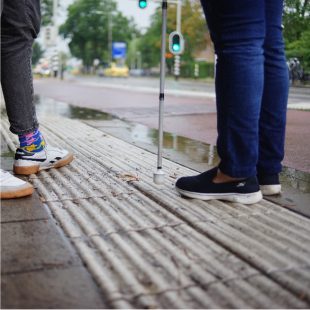 Photo by Jord de Kat Angelino
Photo by Jord de Kat Angelino
Approach
Taken approach
Design with empathy
The primary approach is to stay as close as possible to the real-world setting by designing with empathy. This is done by looking to the context from different angels by doing research and design explorations. Besides the conversations/observations I had with VIPs and experts, the project started off by experiencing what it is like being a VIP myself. I simulated this by wearing obscured black glasses and explored what daily life is like without the use of your visual sense. During this ‘own experience exploration,’ I experienced which activities created anxious feelings and which activities were not scary at all.
“A designer should not do the thinking for people, but really try to think and experience from their perspective as much as possible.”
– Laura Koot –
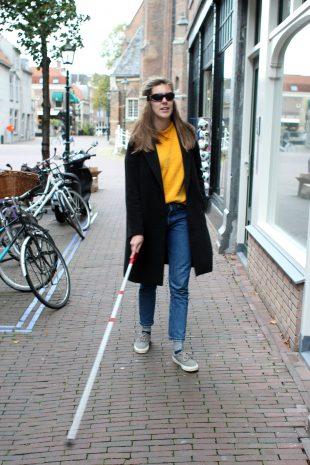
Photo by Margot Overvoorde
My vision
Support impulsivity
According to the done research being in control is an important aspect for VIPs to be able to remember the route, walk smoothly and prevent mistakes. Besides VIPs do not walk new routes on their own, due to the uncertainty. Although the definition of autonomy is about freedom from external factors. There is found an opportunity to design for impulsivity within the mobility context.
Is there room for impulsivity while being in control?
– The found opportunity –
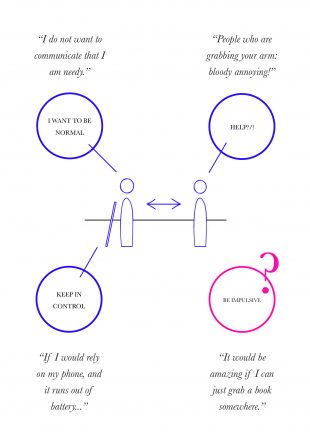
Inspiration
Be like a flaneur
The design is inspired by the mindset of a flaneur which strolls through a known city with eyes wide open and searches for new elements in the known environment. The flaneur’s meaning originally derives from France where a monarch was experiencing the city incognito (Weijts, 2018). His focus is gaining experiences in the known environment without having a purpose or expectations.
A flaneur is a good example of being impulsive by making small detours in the known environment. Although VIPs do not experience new places on their own as mentioned before. VIPs walk a number of known routes repeatedly by following their known recognition points. Currently they are 100% focused on fulfilling this as good as possible. If VIPs feel supported, it will open the possibility that there is no need for 100% focus. Being impulsive means in the VIP mobility context being for a moment mentally distracted from the current route. Therefore, the found definition of impulsivity is making a small mental detour by being distracted by others sounds of the streets beside the recognition points.
Provide support to make a small mental detour
– The design goal–
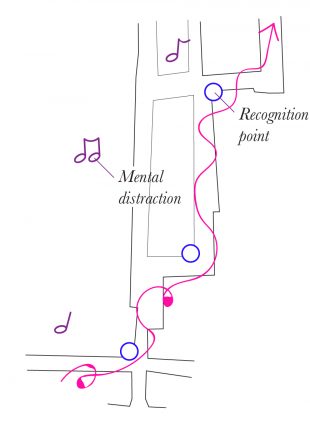
Result
The design – Walkmen (233)
Walkmen is a support tool which is a GPS connected voice recorder on your smart-phone. With the Walkmen application, you can track routes by recording voice memos and create your own mobility tool with a personal library. Once recorded, the user can listen back to the recordings based on the current location when nog 100% sure, due to GPS. In this way, you can play forward and rewind through the route: like a digital Walkman.
If you are wondering… YES! VIPs do use a smartphone! Just like everybody else, but they make use of the ‘voice over’ tool on their smartphone.
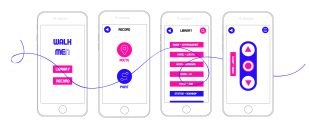
Autonomy characteristic – Trust
To let go of control, it is important to trust the provided information. Who do you trust the most when it comes to your own recognition points as a VIP?
Autonomy characteristic – Requested assistance
Feeling autonomous is not about receiving less help, but it is about the type of help. This is in terms of receiving help when you need it (listen to the recordings when you ask for it) and the type of recorded information at preferred recognition points.
Autonomy characteristic – Freedom of choice
Have the mindset of a flaneur means interpreting the world around within your own world of interpretation. This freedom of choice allows you to make mistakes. With Walkmen you decide which routes you want to record and how you want to record. Nobody else is deciding for you!
“The freedom of usage triggers me. I can use is, although I did not plan it beforehand”
– Reaction from VIP about Walkmen –
Sources:
Stevenson, A., & Lindberg, C. (2010). Dictionary of American English (3rd ed.). Oxford University Press.
Weijts, C. (2018, April 26). Flaneren moet je leren, zeven lessen om zorgeloos te slenteren.



